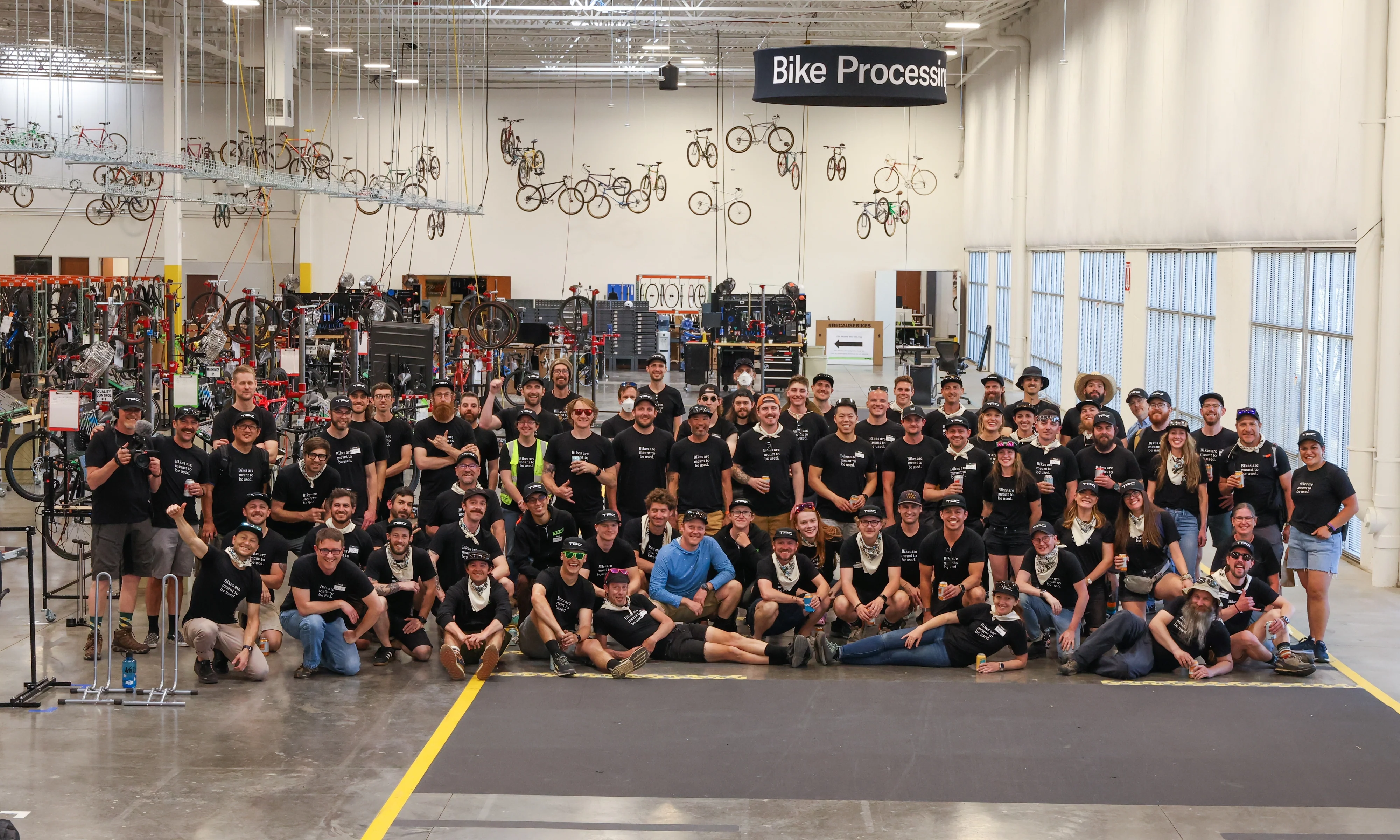Plain water? We need CARBS! Photo: Ian Matteson
To fuel yourself for endurance cycling events like Unbound Gravel, you can't just "eat a lot." What you eat and how you eat matters. If you go into your next long race without a plan, you’ll leave performance on the table and set yourself up for extra undue suffering.
If you follow pro racing, you may have heard about “the carbohydrate revolution.” Races are getting faster because riders are ingesting significantly more carbs on the bike than they did 5-10 years ago. Our knowledge of fueling for performance has improved, and so have the products riders use for fueling. The great news is that us everyday riders and racers can take advantage of all of this too.
We've tested many different nutrition products and strategies and talked to nutrition experts on how pro racers eat and drink. Through trial and error, I’ve settled on the best nutrition products for me and a fueling strategy that keeps my life simple, my gut happy, and my performances slightly above average.
[button]Shop Cycling Nutrition[/button]
How Much and How Often You Should Eat on the Bike

Yeah, you're going to have to carry a lot of food.
For performance, consuming anywhere between 90-120 grams per hour is recommended by most nutrition experts.
When we say “carbs,” we mean simple carbohydrates in the form of sugars or starches that are easy to digest. When fueling yourself on the bike, you want simple and quick energy that won’t stress your gut.
Keep in mind that 90-120 grams is a wide range. If you’re new to fueling on the bike, you might find it difficult to eat that much. Many beginners might do better experimenting with 70-80 grams per hour, or maybe even less.
For me right now, shooting for around 100 grams per hour is the magic number that I find keeps me feeling strong without causing gut distress. Some people can handle even more. Some people require less (e.g., smaller riders, newer riders). Some pros have pushed the boundaries and can consume more than 120 grams per hour. Everyone is different. Ultimately, the amount of carbs you can eat on the bike is something you need to test before your goal event (more on that in a moment).
The other half of fueling is timing. A good recommendation is to eat something every 30-45 minutes. This keeps you topped up and keeps the portions smaller so they don’t distress your gut (you’ll see this is a common theme). I like eating every 30 minutes and have an alarm on my Garmin head unit set to go off every 30 minutes to remind me to eat something and drink.
Also, it’s best to start ingesting carbs as soon as possible during an event. If not right before the start, then within the first 30-45 minutes. If you wait until you actually feel hungry, you’re already behind and it will be difficult to recover from the hole you'll dig yourself into later.
[newsletter]
PSA: Test Your Nutrition Plan Ahead of Time
I’m a voracious eater in my normal life. On the bike though, my stomach can get sensitive. This happens to a lot of riders. Deep into an endurance event, they lose their appetite or ability to keep eating. In bad cases, they start to feel nauseous or gassy. In the worst cases, they have to dive into a Porta potty to purge evil from their bodies.
All of these scenarios are unideal because your performance will suffer, you’ll lose time, and it just plain sucks. So how do you avoid these outcomes? Test your food and practice eating.
Everyone’s stomach is a bit different. You might find that some food works well, but other food causes gut distress. In the 2-3 months leading up to my goal race, I test my drink mix, gels, chews, and other food on my longest training rides or highest-intensity workouts/group rides. These rides simulate the conditions of racing, so they’ll give me a good idea if something will work well for my stomach.
You also need to do this in the weeks or months leading up to an event to train your gut to digest and use the fuel you’re giving it. It gets harder to eat the longer a race goes on. The ability to eat a lot and eat deep into races is something that needs to be trained just like you train your legs.
Drink Mix Is the Easiest Way to Boost Carb Intake
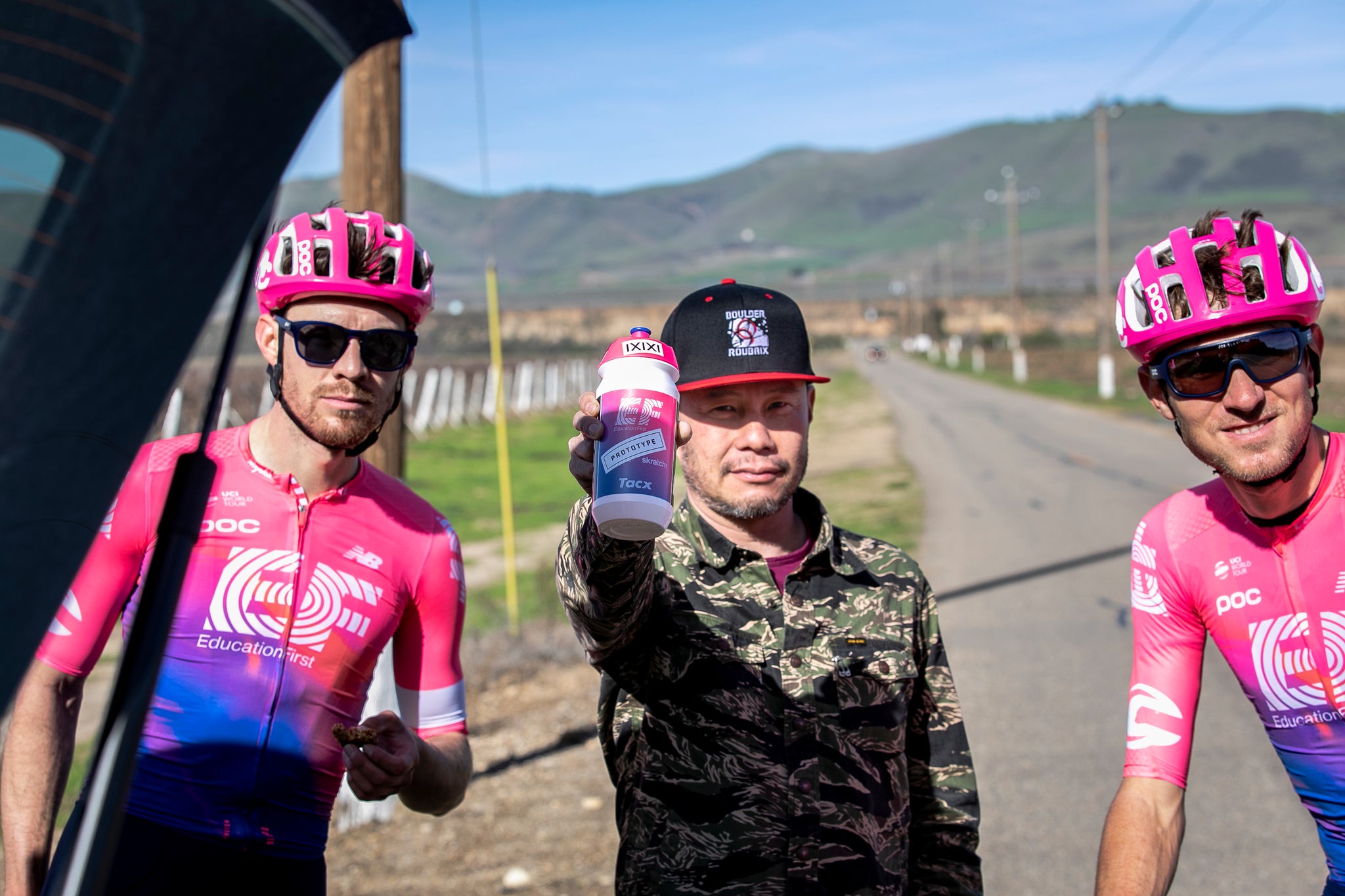 Pros have used carb mix for years. The EF-Education team uses Skratch Super High-Carb. Photo: Greg Erwin
Pros have used carb mix for years. The EF-Education team uses Skratch Super High-Carb. Photo: Greg Erwin
The first key product I use in my fueling strategy is carb mix. Adding carbs to your bottles and/or hydration bladder is the easiest way to boost your carb intake.
[product-block handle="7446339289280-tailwind-nutrition-endurance-fuel-hydration-mix"/]
[product-block handle="tailwind-nutrition-endurance-fuel-caffeinated"/]
My favorite right now is Tailwind. I like Tailwind because it doesn’t get gritty or make my mouth feel sticky. It tastes good without being sickly sweet and I can load 2-4 scoops into a bottle and it still mixes up smoothly. At 25g of carbs per scoop, you can have 50-100 grams of carbs per bottle. I’ll be using it in my hydration pack too.
The best thing about Tailwind though is how easy it is on my stomach. I used to drink GU Roctane, a super popular maltodextrin-based mix, which worked extremely well but made me feel super gassy after 3-4 hours. My preferred gels also use maltodextrin, so after testing things out, I decided to use Tailwind in my bottles to limit my maltodextrin intake and keep my stomach happier. Tailwind uses other sugars, yet it still has the ideal ratio of glucose to fructose (~3:1) for optimal absorption.
[product-block handle="6696596570304-skratch-labs-sport-superfuel-drink-mix-lemons-and-limes-8-serving-resealable-pouch"/]
Another option I’ve liked is Skratch Super High-Carb, which has 100g of carbs per serving. It’s one of, if not the most carb-heavy drink mix on the market. It uses “cluster-dextrin” which is supposed to be easier to absorb than maltodextrin. It’s also super expensive so I don’t use it often.
In the past, I used Skratch Super High-Carb in my bottles at the start of Unbound. This is when the race is the most chaotic and stressful because you’ll be riding in big groups so it will be harder to eat other food. Drinking a denser carb mix will help me stay fueled early. This year though, I’ll stick to Tailwind in my bottles and hydration pack just to keep things cheaper and easier on the stomach.
One thing worth mentioning is that homemade drink mixes using sugar, bulk maltodextrin, or other drink mix powders are much more affordable than these pre-made options. There are tons of recipes online if you look. I’ve tried homemade options with success, but I’m a bit too lazy to bother and nothing I’ve made myself tastes as good as Tailwind does.
A Note on Bottles and Cages
Make sure your cages hold your bottles securely. In the really rough sections of gravel races like Unbound, I always see a lot of ejected bottles. Losing a bottle containing your hydration and carbs can put you in a really bad spot.
I lost a bottle at Unbound in 2022 when I was between the two checkpoints, and I got so thirsty in the heat that I considered drinking from a puddle on the road. Luckily I came across a rider who was dropping out. He gave me his bottle and saved my race. Now I run tubular cages that I can bend to get a secure hold on my bottles.
Energy Gels Provide an Instant Hit of Carbs
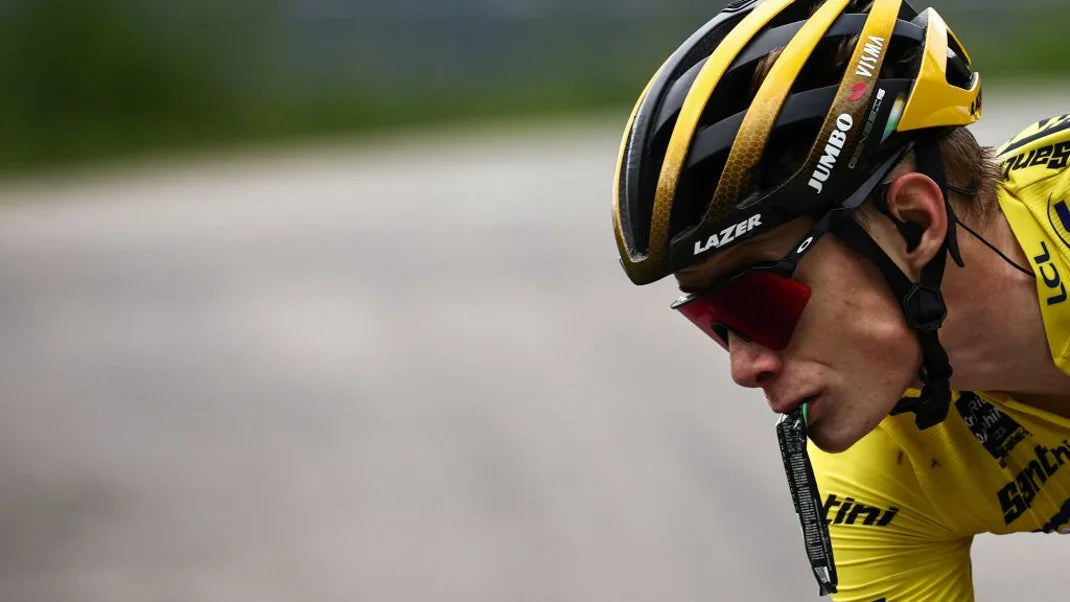
Smashing gels helped Jonas Vingegaard win two consecutive Tours de France. Photo: Anne-Christine Poujoulat
After drink mix, gels are the easiest way to eat carbs fast. I like gels because they’re super compact. I can carry dozens in one pocket. When I eat one, I can often notice the effects within minutes.
For years, I’ve trained and raced with GU gels, mainly because they’re easy to find almost anywhere. A lot of races supply GU at aid stations and I like the taste of several of their flavors. My favorite is the salted watermelon flavor (which also has caffeine in it). One standard GU gel has 23 grams of carbs. I’ve even done entire 100+ mile races on nothing but drink mix and GU gels.
[product-block handle="carbs-fuel-original-50g-energy-gel-18-pack?variant=44331451875520"/]
Another gel I like is “Carbs Fuel.” It’s a lot bigger than the GU gel, and that’s because it has 50 grams of carbs. It has the best dollar-to-carb ratio of any gel on the market. These have a hint of citrus flavor that isn’t exactly tasty, but it is pretty light and inoffensive to me.
I’ll likely carry a mix of GUs and Carbs Fuel gels. These are both maltodextrin based gels though, so they do give me gas. Unlike drink mix, I find the worst gas doesn’t hit me until long after the finish (my wife will sometimes kick me out of bed later at night). If you’re sensitive to maltodextrin, Honey Stinger gels and Untapped Maple Syrup are good “natural” alternatives.
Energy Chews are More Palatable and Have Substance
Some people are pretty grossed out by gels. If that’s the case, then I suggest relying on gummies, which are often marketed as energy chews. These provide a similar quick hit of carbs, but feel more like eating “real” food.
My favorite is the classic CLIF BLOKS energy chew. These come in a sleeve of 6 chews. I cut these sleeves in half, which makes them fast and easy to squeeze out. A half sleeve has 24 grams of carbs. Again, my go-to flavor is salted watermelon.
[product-block handle="7266640494784-skratch-labs-sport-energy-chews-blueberry-50mg-caffeine-10-pack"/]
Skratch also makes good energy chews. I find the packaging is less convenient to open and eat on the bike. The flavor and texture, however, is amazing. To me, Skratch chews are closest to actual candy.
Candy is the Cheap Alternative Fuel Source

Simply the best.
The biggest downside to sport-specific gels and chews is price. It often costs over a dollar per gel or package of chews. This can add up if you’re riding a lot and eating them every 30-45 minutes.
Is there a cheaper alternative? Yes, it’s called candy.
There’s a lot of candy out there — gummy bears and Sour Patch Kids are always favorites — but my go-to is Swedish Fish. It’s easy to eat. You can eat a lot without your mouth getting sticky or gross. It’s not crazy sweet so I find them appetizing deep into races. They don’t get gooey in the heat, which is good.
Swedish Fish also have the right ratio of glucose to fructose for optimal fueling. Trevor Connor, who has a Master’s degree in nutrition and is the CEO and co-founder of Fast Talk Labs explained why these are the best choice:
“We can only absorb so much glucose and fructose per hour, and it varies by person. Glucose is often absorbed at 60-90 grams per hour. Fructose is only 20-30g/hr. You want food or drink mixes in a 3:1 glucose/fructose ratio. A lot of candies, particularly in the U.S. are sweetened with high fructose corn syrup — 40-55% fructose — so that’s the wrong ratio. I generally look for candies (like Swedish Fish) with glucose as the first ingredient.”
If you want to do what the cool kids do though, all the young guys at TPC seem to like Nerds Gummy Clusters, which… sure.
The big problem I have with candy is that I tend to eat it whenever it’s in the house, which is not good for my diet. I’ll only eat energy gels and chews on the bike, which is better for my overall health.
Include Some “Real” Food Too
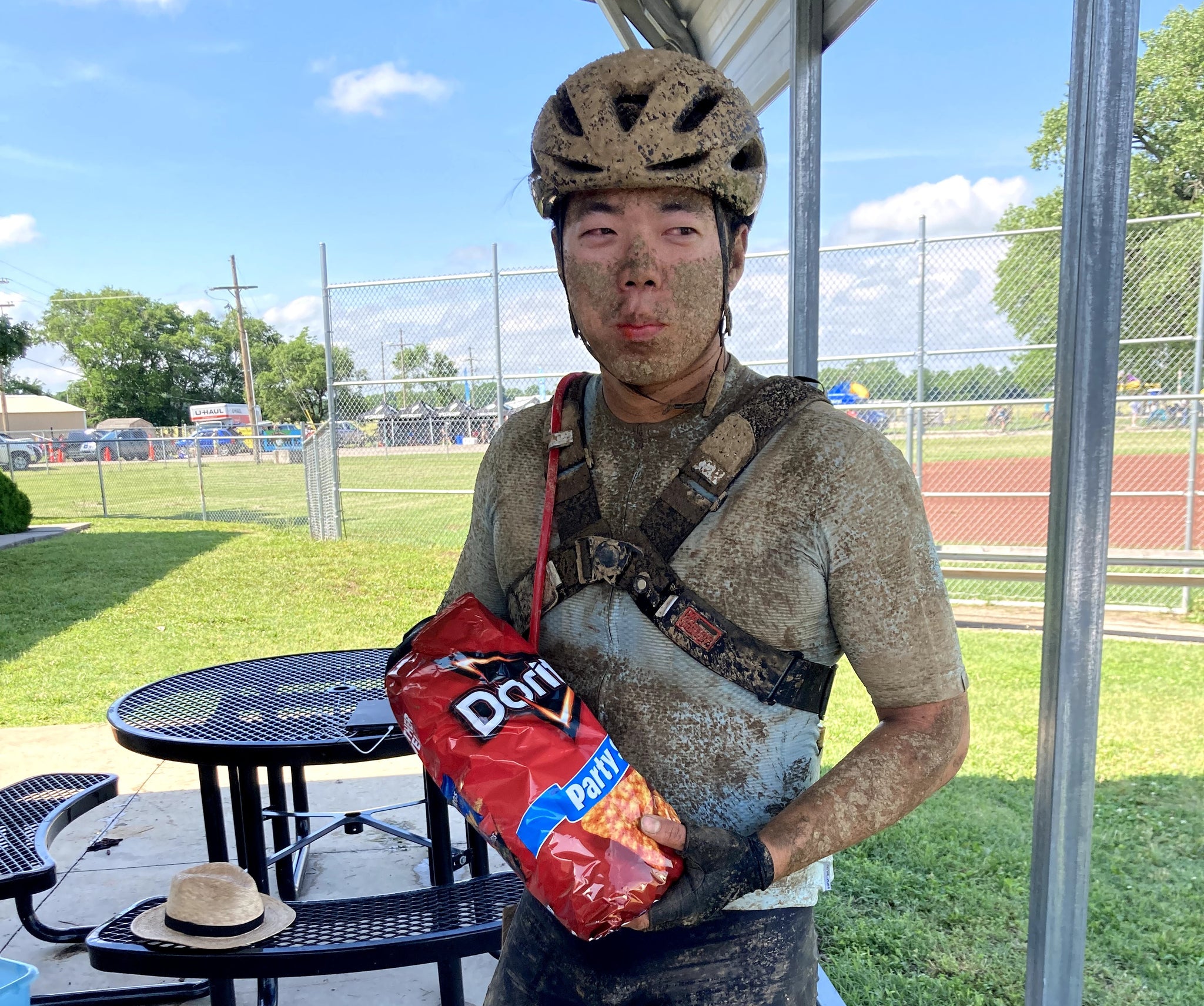
Doritos bring me joy.
It’s always nice to have some “real” food, something that can fill your stomach a bit more. Beyond drink mix, gels, chews, and Swedish fish, I really only carry one other carb source with me on the bike: Rice Krispies Treats.
[product-block handle="vafels-stroopvafels-box-of-12"/]
Other popular options include bars, stroopwafels, pop-tarts, and cookies. I just like Rice Krispies. They’re so bland and simple that I can still eat them when I feel like I’m near death. At only 17 grams of carbs per bar, they’re not efficient in terms of space, but they weigh nothing. They make me happy, and that’s important. They’re a childhood comfort food that I can always rely on. I love to smash a gel, then eat a Rice Krispies Treat to keep my stomach feeling full and happy.
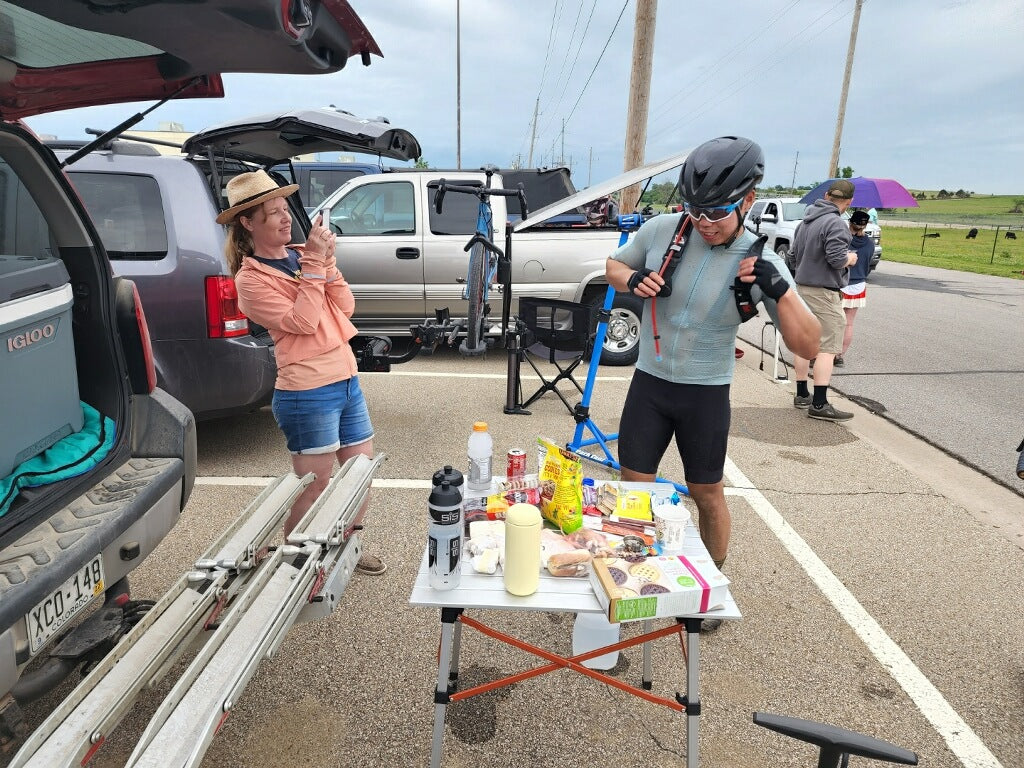
My wife had a lot of options ready in 2022. I left checkpoint 1 after eating my fill of cookies, rice cakes and half a sandwich.
Otherwise, at the checkpoints, my support crew will often have more “real” food for me. I usually have Oreos and Doritos, because they’re also childhood comfort foods for me. I also plan to bring bananas, homemade rice cakes, and maybe a sandwich. I find that you kind of don’t know what you’ll be craving, so it’s good to bring a variety of salty and sweet things you think you might like. You’ll know what you want once you’re there.
Caffeine is the Ultimate Performance Enhancer.
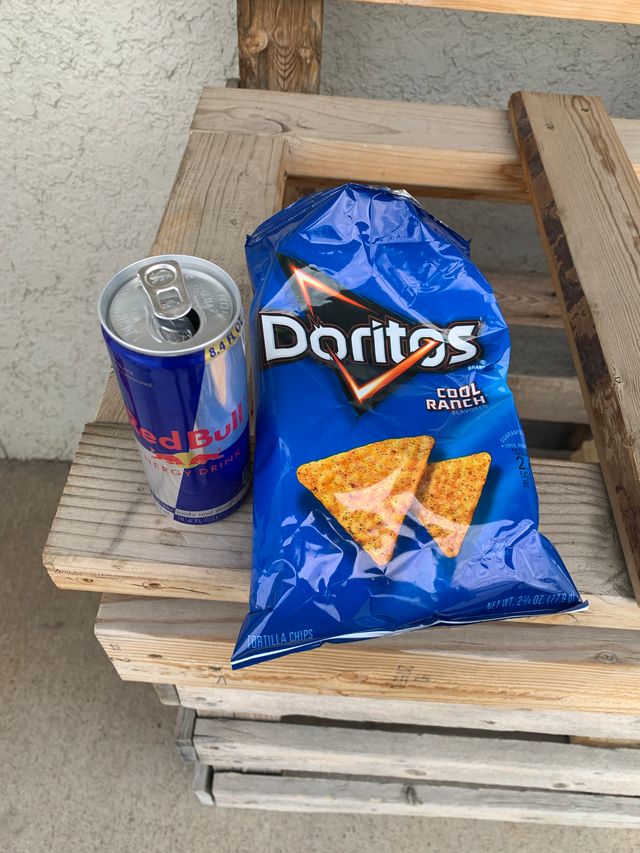
My go-to gas station treats.
Caffeine is the best legal performance enhancer cyclists can use. I’ll have plenty of caffeine in my bottles and gels, but I like getting an extra pick-me-up at the Unbound checkpoints. I’ll have Coke, which is the classic choice, at both checkpoints. But at checkpoint 2, I will also drink my secret weapon: a can of Red Bull.
This is something you definitely want to test in training to see how your body reacts. Also, it doesn’t have to be Red Bull. I just like it. But Coke, coffee, and caffeine gum also work. I tend to stop at gas stations to grab a Red Bull near the end of my longest training rides and it feels like magic.
When I drank a can at checkpoint 2 in 2022, I felt revitalized and felt surprisingly strong powering over the remaining hills. Obviously, your mileage may vary. I don’t expect this to work for everyone.
Carry Salt Sticks If You Fear Heat and Cramps (Maybe)
[product-block handle="salt-stick-fast-chews"/]
There is one more thing I’ll be carrying on the bike: Salt Stick chews. I started using these last year after I had some really bad cramping issues at SBT GRVL because of the heat. Unbound is known for extreme heat, so when the temps start rising I’ll supplement my food intake with these.
I don’t actually know if these will prevent cramps. So far, in my testing, they don’t seem to harm my performance or affect my stomach. My co-worker, Adam Vadeboncoeur, is an elite ultrarunner and he swears by them, so I figured I’d try them. I’ll likely have to wait for true summer race conditions to know if they work for me. I’ll try to report back if they do.
The Fueling Plan
So how does all of this come together?
I’ll be carrying a mix of energy gels, chews, Swedish Fish, and Rice Krispies in my jersey pockets and top tube bag. I’ll have two large bottles and a 1.5L hydration pack full of Tailwind.
Here’s an example for how I might plan to fuel:
- 0 min - 50g gel
- 30 min - 23g gel
- 60 min - 24g chews
- First hour - 97g
- 90 min - 23g gel
- 120 min - 50g gel
- Second hour - 73g
- 150 min - 24g chews
- 180 min - 50g gel
- Third hour - 74g
- 210 min - 23g gel + 17g Rice Krispies Treat
- 240 min - 36g Swedish fish (~5)
- Fourth hour - 64g
This is purely an example. In the chaos of a race, I don’t expect to be able to follow a plan like this precisely. You’ll also notice that I’m not hitting my planned 100g of carbs per hour. This is what the carbohydrate drink mix in my bottles and hydration pack is for.
I will be drinking constantly, with the goal of finishing an additional 325g of liquid carbs by the time I arrive at the first checkpoint after around 4 hours. With the gels, chews, candy, and Rice Krispies, this equates to just over 600 grams of carbs in 4 hours (125 grams per hour). This is MORE carbs than I think I need.
The extra carbs in my drink mix should allow me to make up some carbs when I inevitably miss a feed due to race chaos. It also gives me some wiggle room if I end up being slower than expected. If I’m really short, I can try to top up at the checkpoints.
My biggest piece of advice is don't stress too much about sticking to a super rigid fueling plan. Races rarely go perfectly, and you might find yourself in a situation where sticking to a fast group or trying not to crash takes precedence. That’s fine. Do what you need to do and try to remember to eat again later.
As long as you know you have food that works for you, just keep eating and don’t stop. That’s the most important thing. Even if you fall short of your goal intake, taking in something is always better than nothing!
Hopefully, this gives you some ideas on how to put together your own nutrition plan. If you have products you like, or tips of your own, I'd love to hear about them!
[button]Shop Cycling Nutrition[/button]










